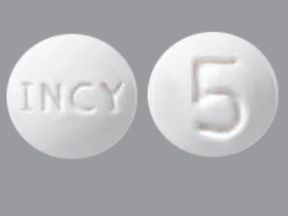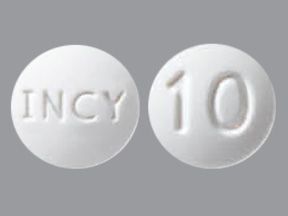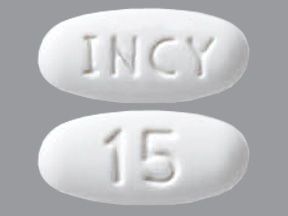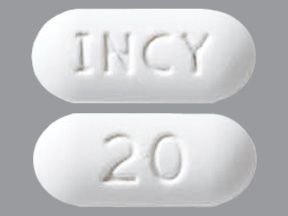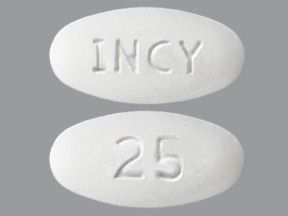Jakafi (ruxolitinib) is a brand-name drug that’s prescribed for graft-versus-host disease and other blood conditions. It’s used in some adults and children. Jakafi comes as an oral tablet that you typically take twice per day. The dosage can vary depending on the condition being treated.
Jakafi belongs to a drug class called kinase inhibitors. Jakafi isn’t available in a generic version.
Keep reading for specific information about the dosage of Jakafi, including its strengths and how to take the medication. For a comprehensive look at Jakafi, including details about its uses, see this article.
Note: This article describes typical dosages for Jakafi provided by the drug’s manufacturer. When taking Jakafi, always follow the dosage prescribed by your doctor.
Read on for more details about Jakafi’s form, strengths, and dosage.
Jakafi form
Jakafi comes as an oral tablet.
Jakafi strengths
Jakafi tablet comes in the following strengths:
- 5 milligrams (mg)
- 10 mg
- 15 mg
- 20 mg
- 25 mg
Typical dosages
The following information describes dosages that doctors commonly prescribe or recommend in adults. However, be sure to take the dosage your doctor prescribes for you. Your doctor will determine the best dosage to fit your needs.
Note: Your doctor will determine and adjust your Jakafi dosage based on the results of certain blood tests. So before starting the drug, your doctor will have you complete blood work. They’ll likely check in every 2–4 weeks during treatment and adjust your dosage as needed.
Dosage for myelofibrosis
Jakafi’s recommended dose range for myelofibrosis in adults is 5–20 mg twice per day. The maximum dosage is 25 mg twice per day.
Dosage for graft-versus-host disease
Jakafi’s recommended dosage for acute (sudden) graft-versus-host disease (GVHD) in adults is 5 mg twice per day. Your doctor may increase your dosage to 10 mg twice per day after 3 days of treatment. After 6 months, your doctor may slowly lower your Jakafi dosage. If your GVHD symptoms return, they’ll likely restart your previous dosage of Jakafi.
Jakafi’s recommended dosage for chronic (long lasting) GVHD in adults is 10 mg twice per day. After 6 months, your doctor may slowly lower your Jakafi dosage. If your GVHD symptoms return, they’ll likely restart your previous dosage of Jakafi.
Dosage for polycythemia vera
Jakafi’s recommended dosage for polycythemia vera in adults is 10 mg twice per day. Your doctor may increase your dosage after 4 weeks of taking the drug. The maximum dosage of Jakafi for this use is 25 mg twice per day.
Children’s dosage
Jakafi is used to treat acute and chronic GVHD in children ages 12 years and older. The children’s dosage is the same as the adult dosage. For details, see “Dosage for graft-versus-host disease” just above.
Long-term treatment
Jakafi may be taken as a long-term treatment, depending on the condition you’re taking it to treat. It may take up to 6 months for your doctor to know whether Jakafi is effective for your condition. If you and your doctor determine that Jakafi is safe and effective for you, you may take it long term.
Talk with your doctor about how long you can expect to take Jakafi.
The Jakafi dosage your doctor prescribes will depend on several factors. These include:
- the type and severity of the condition you’re taking Jakafi to treat
- how well your liver and kidneys work
- your blood test results
- other medications you may take
Other medical conditions you have can also affect your Jakafi dosage.
Dosage adjustments
Your doctor may recommend a lower dosage of Jakafi if:
- you have certain liver or kidney problems, including receiving dialysis
- you take certain medications known as CYP3A4 inhibitors*
- you have certain changes in blood cell counts
Your doctor will determine whether to adjust your Jakafi dosage. If you have questions about your dosage, talk with your doctor.
* CYP3A4 is an enzyme (a type of protein) that helps break down drugs, including Jakafi. So, drugs that inhibit CYP3A4 can, in turn, affect the level of Jakafi in your body. To learn more about medications that may interact with Jakafi, see this article.
Jakafi comes as a tablet that you swallow with or without food. Always follow your doctor’s directions for taking Jakafi.
If you have trouble swallowing tablets, see this article for tips on how to take this form of medication. You can also talk with your doctor or pharmacist.
ACCESSIBLE DRUG LABELS AND CONTAINERSSome pharmacies offer labels with large print, braille, or a code you scan with a smartphone to convert text to speech. If your local pharmacy doesn’t have these options, your doctor or pharmacist might be able to recommend a pharmacy that does.
If you’re having trouble opening medication bottles, ask your pharmacist about putting Jakafi in an easy-open container. They also may recommend tools that can make it easier to open bottles.
If you miss a dose of Jakafi, take your next scheduled dose at the regular time. Do not take two doses to make up for the missed one.
To help make sure that you don’t miss a dose, try using a medication reminder. This can include setting an alarm or putting a note where you’ll see it, such as on your bathroom mirror or bedside table. You could also download a reminder app on your phone.
If you take more Jakafi than your doctor prescribes, you may develop harmful effects. To learn more about Jakafi’s side effects, see this article.
It’s important that you do not take more Jakafi than your doctor advises.
Symptoms of an overdose
An overdose of Jakafi may cause symptoms of:
Your doctor will monitor your blood cell counts during Jakafi treatment. If you have questions about Jakafi and overdose, talk with your doctor.
If you take more than the recommended amount of Jakafi
Call your doctor right away if you believe you’ve taken too much Jakafi. Another option is to call America’s Poison Centers at 800-222-1222 or use its online tool. If you have severe symptoms, immediately call 911 or your local emergency number, or go to the nearest emergency room.
The dosages in this article are typical dosages provided by the drug manufacturer. If your doctor recommends Jakafi for you, they’ll prescribe the dosage that’s right for you. Always follow the dosage that your doctor prescribes.
As with any drug, never change your dosage of Jakafi without your doctor’s recommendation. If you have questions about the dosage of Jakafi that’s best for you, talk with your doctor.
Besides learning about dosage, you may want other information about Jakafi. These additional articles might be helpful:
- More about Jakafi. For information about other aspects of Jakafi, refer to this article.
- Side effects. To learn about side effects of Jakafi, see this article. You can also look at the Jakafi prescribing information.
- Cost. If you’d like to learn about Jakafi and cost, see this article.
- Details about your condition. For details about some of the conditions Jakafi treats, see our list of blood and hematology articles and polycythemia vera articles.
Disclaimer: Medical News Today has made every effort to make certain that all information is factually correct, comprehensive, and up to date. However, this article should not be used as a substitute for the knowledge and expertise of a licensed healthcare professional. You should always consult your doctor or another healthcare professional before taking any medication. The drug information contained herein is subject to change and is not intended to cover all possible uses, directions, precautions, warnings, drug interactions, allergic reactions, or adverse effects. The absence of warnings or other information for a given drug does not indicate that the drug or drug combination is safe, effective, or appropriate for all patients or all specific uses.

